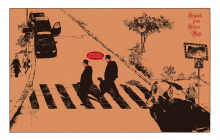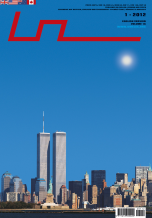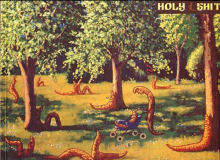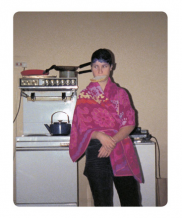| Zeitschrift Umělec 2003/1 >> Summer on Louise Weiss Street i Louise Weiss | Übersicht aller Ausgaben | ||||||||||||
|
|||||||||||||
Summer on Louise Weiss Street i Louise WeissZeitschrift Umělec 2003/101.01.2003 Linda Fournier, Lenka Kavanová | neuigkeiten | en cs |
|||||||||||||
|
"According to the materials of Linda Fournier
written by Lenka Kavanová Louise Weiss Street, as a very important platform of contemporary art, has prepared a summer program corresponding to its reputation as the backers of all that is “in” in Paris. The street offers activities joining different fields of art, full of active and creative streams that have spread through the periphery of Paris from 1997, when a few bold owners of galleries decided to use building changes carried out in the quarter and founded galleries here, that resulted in a very rare phenomenon in the middle of the individualistic environment of contemporary art. Before the annual holiday break in August, from June 10 to July 27 the galleries offer whole sets of exhibitions. The freshness of the town space inspired the galleries — Galerie de Paris, Almine Rech, Art: Concepte, Emmanuel Perrotin, Jeniffer Flay, Praz-Del-lavade — to found a new association named “LOUISE.” The task of the association is to catalyse individual creative capabilities on the basis of mutual agreement and to make this street unique, where solidarity and independence are combined in one place. The first galleries were gradually joined by others: Coretin Hamel, Kreo, Jousse, & and some new cultural centres were founded, e.g. MK (cinemas and exhibitions rooms), within easy reach, and at a landing place on the Seine some boats with a theatre and cultural programmes are moored. Thus they satisfy the needs of the young “mobile” generation. Each gallery supports its own artists and keeps its autonomy. All of them invite you to an opening day, the date of which is the same for all of them and this day is a great event in the diary of all contemporary art lovers. We start the walk at the end station of subway number 14, within easy reach of the Francois Mitterand Library, on Chevaleret Square. And we stand in front of the gallery ALMINE REICH, in which a Norwegian Sven Pahlsson exhibits 3D animations. He mostly uses new technologies: computer animation, video, digital photography, the Internet and so on. Sprawville consists of pictures taking us back to the “American dream” of megalomania and idealism. A boundless world of parking places, uptown quarters without any sign of life — a dead landscape. The pictures are changed at regular intervals and they give us a feeling of dizziness from the void and abandoned Earth. When we now proceed along Duchefdelaville Street, we arrive at the exhibition Present Perfect in the gallery. The esthetics of this art group are firmly joined with the actual presence. Its art show uses a disarming naivety and cruel cynicism and the artists in this space re-define reality, in which mixes experience and a dream, wish and frustration (the works of Pia Rönic and Jakob Kolding). Suzanne Jirkuff examines the information field and plays with anonymous spaces, reality, and fiction as well as media lies. Alban Hajdinaj studies, in the creation of parallel worlds, its unsteady identity, Elise Florenty deals with “masscult” and the difference existing between reporting and fiction. Fernando Bryce records a new social history in an atlas called “The condition of society.” A little further in the gallery Art: Concept Madeleine Berkhemer presents the project Afraid. This small Dutchwoman defines individual stereotypes of women: a naive woman (she calls her Milly), a hard and sexy woman (Molly) and a bourgeois materialistic woman (Mandy). In her work, which is sexy almost pornographic, she resorts to the fetishism of stockings and tights, which seem to be indefinitely extensible. She tears them into rags and she plays with an image of the penetrating and penetrated. Pornographic collages and organic sculptures form a pupa in the stage of mutation, a supernatural and voyeuristic vision of female microcosm. But back directly to Weiss Street No. 5, where Emmanual Perrotin reminds us that a 50th Venetian Biennale will take place. The exhibition is entitled Au meme moment, dans la lagune or “Just now in the lagoon.” Maurizio Cattelan gripped the attention of the audience during the Venice Biennale in 1993, when he rented the space assigned to him to an advertising agency, warning about the dangerous relations between media and the art. In 1999 he surprised visitors with a true sculpture of a fakir filled with earth, a symbol of the cynic and supercilious chasm that contemporary art sometimes imposes on us. The presented Scandinavian couple — Elmgreen & Dragset — have worked together since 1995. As their regular live exhibition “Paris Diaries” proves, they choose sociological points of view and they use the exhibition rooms in an entirely non-conforming way. During the concept Work in Progress extracts from the intimate diaries of five young men (as psychological and behaviouristic samples) are overplayed in front of the eyes of the astonished visitors. Photographer Piotr Uklanski is interested in banal matters and events through the filter of pop-estheticism and dream symbolism. Murakami joins traditional Japanese art with a folk imagination Mango. We have to mention the Italian Paola Pivi as well. The next space of the Galerie Perrotin is in No. 30. Guy Limone presents himself with the exhibition “I count on you” where an electric counter records exactly the number of visitors. A yellow line of small plastic figures represents the total number of visitors to the exhibition “Alone in the world” that took place in the summer of 2002. Under the yellow line grows a similar red line that is extended for every 200 new visitors. This line shows the actual status and the final status will be shown on July 26. The only stable elements of the exhibit are the neon lamps with photographs from the artist’s travels that are colored according to the appropriate countries. In the gallery Jousse Enterprise, under the motto “Economic crisis is fantastic, decadence is wonderful” that is the name of a music hit from the 1980s, we can see how an actual theme can be treated with humour and irony. The group White Trash remixed this popular song for this exhibition and the gallery issues it on a CD and vinyl. The presentation of the “Group Show” works with a critical attitude to the social society, in which cynicism and irony are joined. For example, Mirrors by Phillip Meste reflect a hard and questioning vision about forbidden delight. Non-accompanying letters by Julien Previeux create the same atmosphere — with surprising prescience and a tragic-comical tone it records the evident non-adaptability of an individual in an environment, in which he or she lives and the absurdity of social reality. Gianni Motti presents himself as an art terrorist who requires an earthquake in California and telepathically sent blackmail letters to the Columbian president Samper. He behaves like a virus in the media and his omnipresence in the pictures of its assistants in all places around the world evokes the intrigues of “Big brother” who has a very good time. In the collection Play off 2003 he toys with the endeavours of politicians to integrate themselves through some play (in this case a sport) in the world of citizen X, this is a very comical image, only because of the artificiality of such an effort. Gérard presents himself as a fetishist collector when presenting his treasures that he has collected as an adventurer during his whole life and these treasures are material witnesses with an emotional and memorial value. He presents himself as a garbageman of sentimentality; he collects pictures, photos and various objects. Drawings from a concert of the mythical music group Virgin Suicide made by David West are beside the pictures of Van Lieshout and the heroic, typically proud Turkish portraits made by Timur Celigdaga are hung just beside the pictures of addicts and children from a street in New York, made by photographer Muzi Quawson. We must mention something of the works of Alexandra Mir, Schohayy, Frank Perrina, Gilles Mathé and others, in order to entice you to visit it. In the gallery Praz - Delavallade, Frazer Sharp show us a phantasmagoria apparition from his memories. His pictures, created according to his photography, have simple topics that allegorize a world of secret images from childhood. The pictures have to be seen from a distance, because only then will the color smudges create certain forms. The pictured figures are inaccessible, mysterious as if they are imprisoned in the pictures. The gallery Air de Paris presents the project Électricité by Francois Curlet and in a projection hall Body double 16 and 18 by Dellsperger. Curlet, born in 1967, lives and works in Brussels and Paris and he concentrates on the features of perception. His work focuses on stimuli, which are not limited by unambiguous and limiting literature. The observer is led only by his own uncertainty and the ’senses-language’ of the objects. The project Moonwalk is created as a light marking the way for a lunar walker and the project Daliphone is a kind of technological seashell that produces the voice of a genie. Curlet’s questions are intentionally left unanswered; his hidden work refuses normality or subjection to formal criteria. Dellsperger’s films are “recycled” sequences from films of all genres, a hallucinatory remake of the iconic scenes from Hitchcock (Psycho), Brian de Palma (Dressed to kill, Body double, Blow out, Obsession), Georges Lucas (Return of the Jedi) … Dellsperger develops a factuality and he uses imitations with androgynous actors and transvestites, he analyzes the original in order to bring back to life the worn out psychedelic context. For example Body double, which is literally a twin of the original, refers to the dubitable, ambiguous and ephemeral fiction that makes from the script an abstraction that is the source of changes in the original text. And finally something very short: Jousse Enterprise exhibits architectonical furniture from the fifties (Jean Prouvé, Charlotte Perriand, Matthieu Matégot, etc.) in No. 34. This summer, the gallery gave Mathias Joussea a free hand, so he has prepared, in cooperation with the gallery Guillaume de Casson (boulevard Vincent Auriol), an exposition of the decorator and designer Michel Boyer. It includes his work from the seventies, when he worked on increasing the value of metals. Boyer bent them with exceptional elegance and created low tables, stools and desks. But he added to the metals entirely new materials, such as laminate or glass fibre, which were new materials at that time. He was already successful with them from the sixties because he created some prestigious interiors, e.g. Bank of Rotschild in Paris and the studios of the Paris designer Lanvin. What more is there to say? Contemporary design can be found at the gallery Kreo (Mattia Bonetti — “Géometries”), gallery Cornetin Hamel, a show window at Nano Galerie and finally some sad news: gallery Jennifer Flay has definitively closed shop. So let’s meet on rue Luise Weiss! For more information write to Sandy Hattab, Association Luise — luise13@fresesurf.fr "
01.01.2003
Empfohlene Artikel
|
|||||||||||||
|
04.02.2020 10:17
Letošní 50. ročník Art Basel přilákal celkem 93 000 návštěvníků a sběratelů z 80 zemí světa. 290 prémiových galerií představilo umělecká díla od počátku 20. století až po současnost. Hlavní sektor přehlídky, tradičně v prvním patře výstavního prostoru, představil 232 předních galerií z celého světa nabízející umění nejvyšší kvality. Veletrh ukázal vzestupný trend prodeje prostřednictvím galerií jak soukromým sbírkám, tak i institucím. Kromě hlavního veletrhu stály za návštěvu i ty přidružené: Volta, Liste a Photo Basel, k tomu doprovodné programy a výstavy v místních institucích, které kvalitou daleko přesahují hranice města tj. Kunsthalle Basel, Kunstmuseum, Tinguely muzeum nebo Fondation Beyeler.
|








































 Potsdamer Str. 161 | Neu Divus in Zwitschermaschine, galerie und buchhandlug in Berlin! | Mit U2 nach Bülowstraße
Potsdamer Str. 161 | Neu Divus in Zwitschermaschine, galerie und buchhandlug in Berlin! | Mit U2 nach Bülowstraße
Kommentar
Der Artikel ist bisher nicht kommentiert wordenNeuen Kommentar einfügen